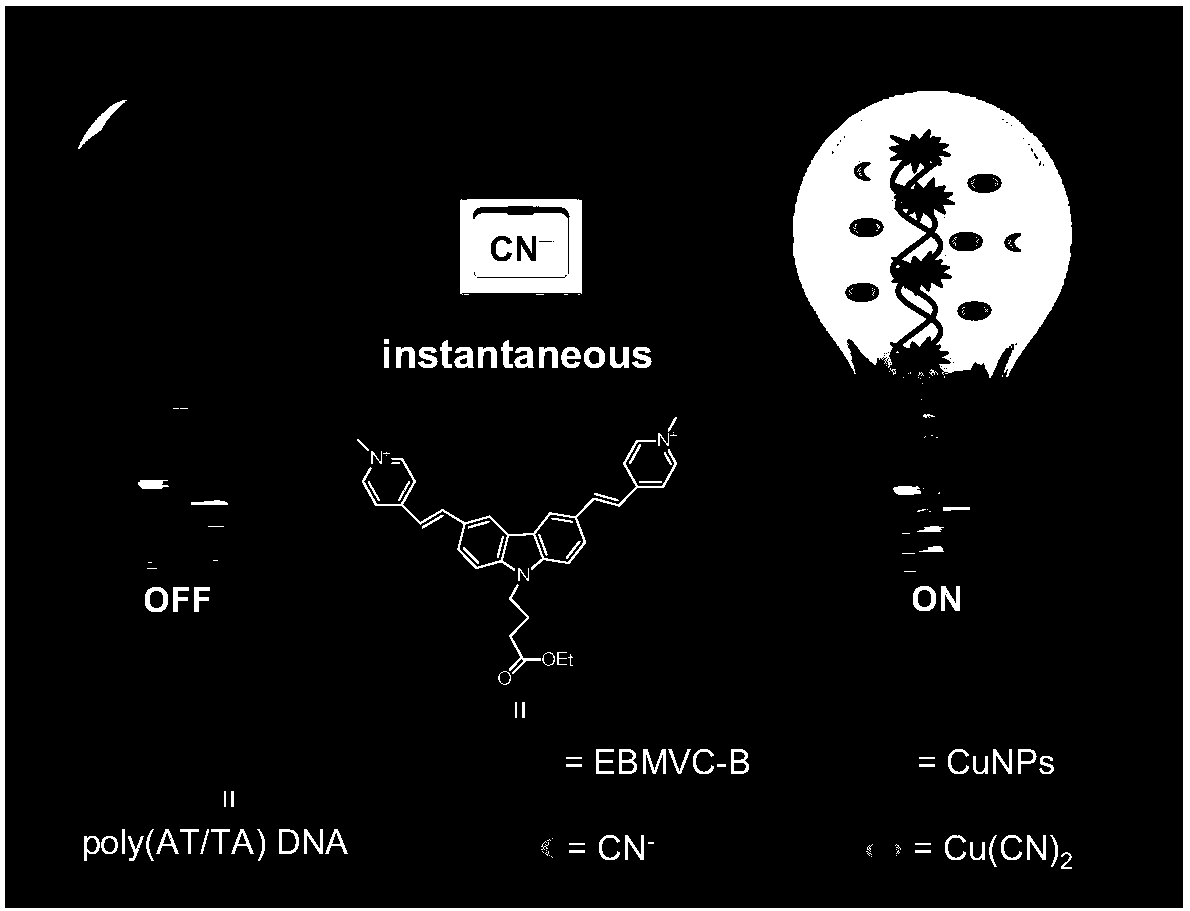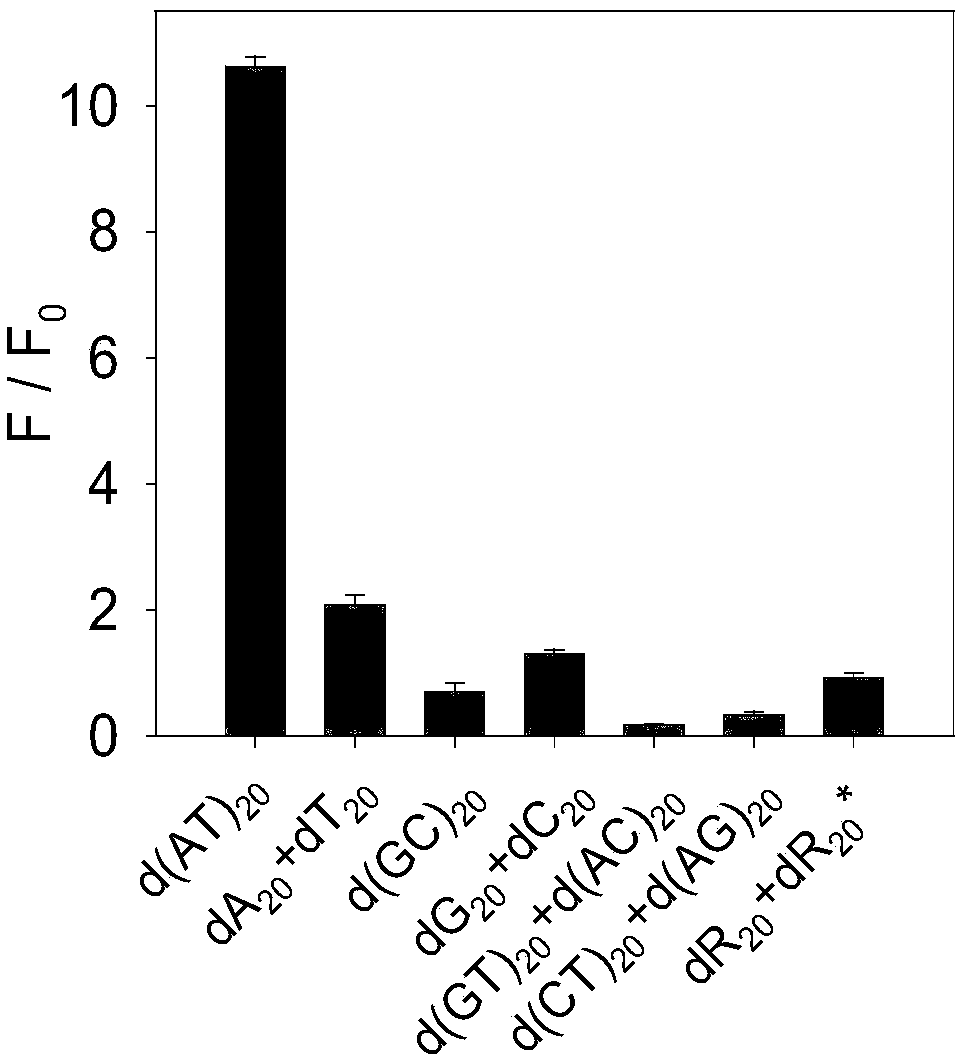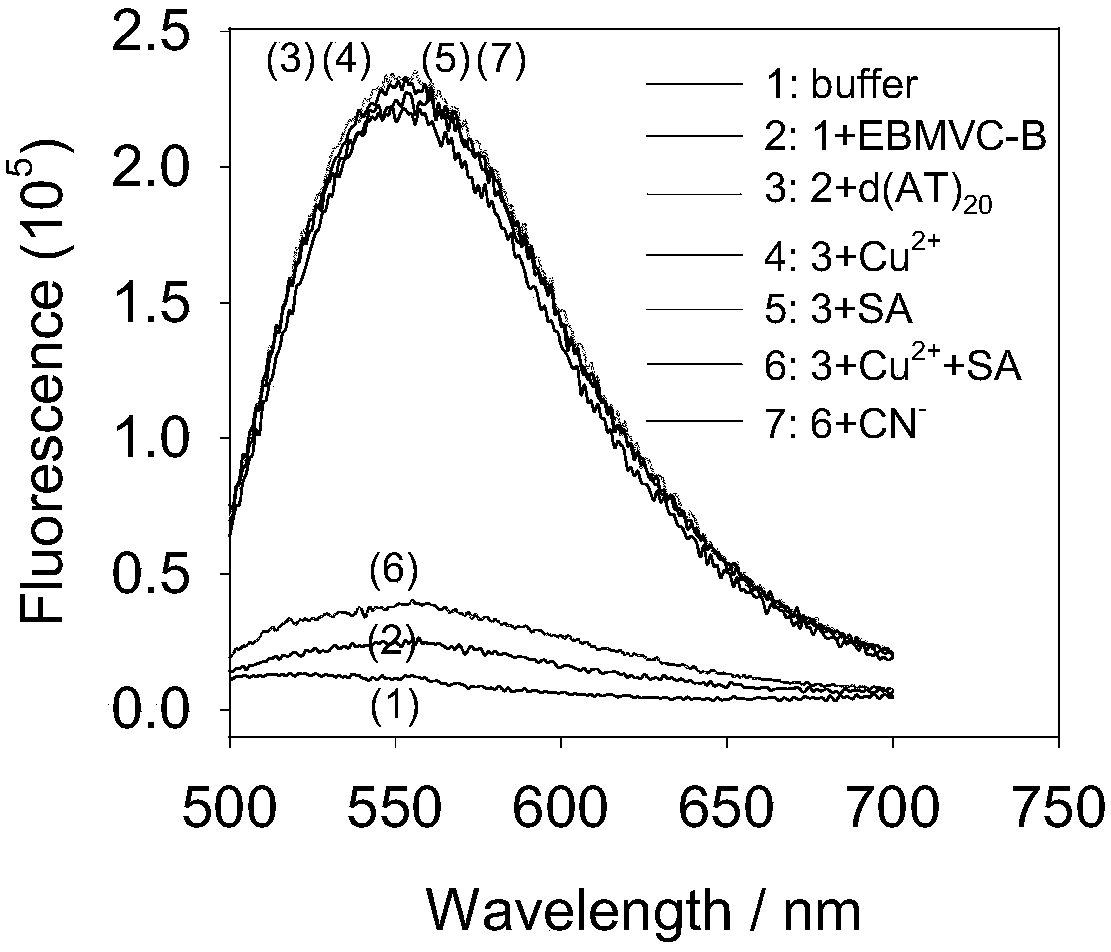A kind of rapid detection method of cyanide ion
A detection method, the technology of cyanide ion, which is applied in the field of nanotechnology and analysis and detection, can solve the problems of short half-life of cyanide ion and analysis error, etc., and achieve the effect of fast detection speed, easy operation and good social value
- Summary
- Abstract
- Description
- Claims
- Application Information
AI Technical Summary
Problems solved by technology
Method used
Image
Examples
Embodiment 1
[0041] Example 1 Different DNA sequences are used in the construction of nanocomposite probes and their responses to cyanide ions
[0042] Prepare the solution required for the preparation of nanocomposite probes: dissolve the dry powder containing different DNA sequences of the same length in water to obtain a 10 μM stock solution, prepare a 50 μM EBMVC-B solution, and prepare 2 mM copper sulfate (CuSO 4 ) solution, prepare 100mM sodium ascorbate (C 6 h 7 NaO 6 ) solution, prepare 10 mM MOPS buffer solution (pH=7.8), and place it in a refrigerator at 4°C until use.
[0043] (1) Add 480 μL of MOPS buffer solution (10 mM, pH=7.8) into an EP tube with a volume of 1.5 mL; then add 5 μL of DNA solution (10 μM) and 5 μL of EBMVC-B dye solution (50 μM), shake well and let stand 2 minutes; then add 5 μL of copper sulfate solution (2mM) and 5 μL of sodium ascorbate solution (100mM), shake well, and let stand for 2 minutes; directly measure and record the fluorescence of each group ...
Embodiment 2
[0046] Example 2 Feasibility Analysis of Nanocomposite Probes for Cyanide Ion Detection
[0047] By single variable method, the influence of each reaction component on the fluorescence signal was systematically investigated.
[0048] (1) Add 480 μL of MOPS buffer solution (10 mM, pH=7.5) into an EP tube with a volume of 1.5 mL;
[0049] (2) Add 5 μL of the optimally obtained double-stranded d(AT) 20 solution (10 μM);
[0050] (3) Add 5 μL of EBMVC-B dye solution (50 μM), shake well, and let stand for 2 minutes;
[0051] (4) Add 5 μL of copper sulfate solution (2 mM);
[0052] (5) Add 5 μL of sodium ascorbate solution (100 mM), shake well, and let stand for 2 minutes. Sodium ascorbate is abbreviated as SA in the drawings of this invention.
[0053] (6) Finally, add 5 μL of cyanide ion solution (2 mM) and shake well.
[0054] Test and record the fluorescence spectra of the above steps respectively.
[0055] Analysis of results: from image 3 It can be seen from the fluore...
Embodiment 3
[0056] Example 3 Kinetic Analysis of Nanocomposite Probes for Cyanide Ion Detection
[0057] Set the parameters of the fluorescence spectrophotometer, excitation wavelength=450nm, emission wavelength=550nm, and perform time scanning.
[0058] (1) Add 480 μL of MOPS buffer solution (10 mM, pH=7.8) into an EP tube with a volume of 1.5 mL, and scan for 100s-200s;
[0059] (2) Then add 5μL d(AT) 20 Solution (10μM), shake well, scan for 100s-200s;
[0060] (3) Add 5 μL of EBMVC-B dye solution (50 μM), shake well, and scan for 100s-200s;
[0061] (4) Then add 5 μL of copper sulfate solution (2mM), shake well, and scan for 100s-200s;
[0062] (5) Add 5 μL of sodium ascorbate solution (100mM), shake well, and scan for 100s-200s;
[0063] (6) Finally, add 5 μL cyanide ion solution (2 mM), shake well, and scan for 100s-200s.
[0064] Analysis of results: from Figure 4 It can be seen from the time scanning results of the MOPS buffer itself that there is no fluorescence signal; add...
PUM
 Login to View More
Login to View More Abstract
Description
Claims
Application Information
 Login to View More
Login to View More - R&D
- Intellectual Property
- Life Sciences
- Materials
- Tech Scout
- Unparalleled Data Quality
- Higher Quality Content
- 60% Fewer Hallucinations
Browse by: Latest US Patents, China's latest patents, Technical Efficacy Thesaurus, Application Domain, Technology Topic, Popular Technical Reports.
© 2025 PatSnap. All rights reserved.Legal|Privacy policy|Modern Slavery Act Transparency Statement|Sitemap|About US| Contact US: help@patsnap.com



